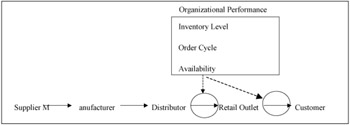Research Model
|
| < Day Day Up > |
|
A supply chain is "a system through which organizations deliver their products and services to their customers" (Poirier & Reiter, 1996). This chain is a network of interlinked organizations that have a common purpose: to achieve the best possible means of affecting that delivery. It, broadly, encompasses all logistic activities, supplier-customer partnerships, new product development and introduction, inventory management, and facilities (Stephens et al., 1997). The basic SC contains the following members: supplier, manufacturer, distributor, retail outlet, and customer.
DeLone & McLean (1992) present an IS success model that has been cited many times over the years. Their basic model is used in this study to examine electronic SC (i.e., website retailing) effectiveness. The purpose of the present study is to determine the effectiveness (organizational impact or success) of electronic SC replenishment when conducting business (retailing) via a website (i.e., the Internet). Therefore, the present study focuses on the overall success measure (organizational impact) as proposed by DeLone & McLean (1992). Organizational impact is the information's effect on organizational performance. In IS studies, organizational impact has been measured primarily with cost and revenue calculations, such as return on investment, return on assets, and market share (Cron & Sobol, 1983; Kaspar & Cerveny, 1985), but since organizational impact or organizational effectiveness is a performance variable, other performance measures related to the application in question may be used.
The organizational impact dimension involves measures for SC link effectiveness. When the performance criteria are subjective, historical information can be used (Lewin & Minton, 1986). Therefore, relative measures of performance may be used to compare the company's performance over time or to compare the performance of the company to other similar companies (Lewin & Minton, 1986). Chow et al. (1994) and Poirier & Reiter (1996) summarize various conceptual and theoretical studies of logistics performance measures. From their research, electronic SC effectiveness (organizational performance) is theorized to be a product of (1) inventory level, (2) order cycle, and (3) availability. Consequently, effectiveness is measured using inventory performance data (inventory level, order cycle, and availability).
A model is developed that incorporates the SC and IS (electronic SC) organizational performance. Each SC link's (replenishment) effectiveness can be measured by the inventory level, order cycle, and availability. The research model is presented in Figure 1. Each link in the SC (supplier, manufacturer, distributor, retail outlet, and customer) could be examined in relation to inventory level, order cycle, and availability; however, the present research study focuses on the distributor-retail outlet link and the retail outlet-customer link. For example, for the distributor-retail outlet link, the order cycle and inventory level are measured. The order cycle is reflective of the distributor used to replenish products. The order cycle will have an affect on the inventory level for the retail outlet and availability of products to the customers (end users). The inventory level is the on-hand quantity of the retail outlet. Therefore, for the retail outlet-customer link, the inventory level held by the retail outlet and the availability of products to the customers are measured. In SC link terms, the effectiveness measures are reflected as follows: order cycle from the distributor, inventory level at the retail outlet, and availability to the customer.

Figure 1: Research Model
Theory suggests that an electronic SC should benefit the retail organization by allowing it to hold less inventory, have shorter order cycles (resulting in less on-order at any given time because should be holding less inventory), and having greater availability of products (resulting in more units sold) (Bowersox, 1974; Harrington et al., 1991; Iyer & Bergen, 1997; Rose, 1979; Strader et al., 1999). When the organization can replenish from its own distribution centers versus outside (third party) distribution centers, one would believe that the organization would have more control, and therefore benefit more, using its own distribution centers. However, in the early stages of electronic retailing, the organization may not see the full benefits of an electronic SC.
For inventory management and buying habits for websites, theory suggests that some products should sell more easily via a website (i.e., perceived less risky) (Bhatnagar et al., 2000). For example, books and electronic items do not require touch-and-feel and therefore should sell more readily. With an electronic SC, however, a faster turnover of products should not dictate higher inventory levels or more orders if the electronic SC relationship is working properly.
|
| < Day Day Up > |
|
EAN: 2147483647
Pages: 191